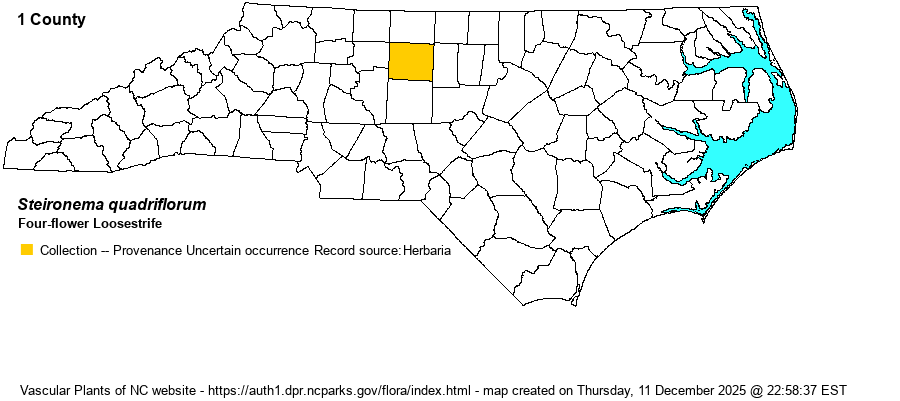| Author | (Sims) A.S. Hitchcock | |
| Distribution | Weakley (2018) states "Reported for c. NC by Coffey & Jones (1980), based on 2 specimens; the records seem unlikely but are tentatively accepted." There are many specimens in the SERNEC database labelled as "Lysimachia quadriflora", but an online review of nearly all of the ones that are available for viewing are misidentied L. quadrifolia, a simple mistake in the specific epithet. However, the SERNEC specimen at DUKE, from Guilford County in 1911, was originally identified as L. lanceolata, also a narrow-leaved species, but was re-evaluated and identified by Coffey in 1979 as L. quadriflora. The label says it was collected "in moist soil", a suitable habitat, but the location of "Beischel Farm, Greensboro" is reason for questioning the provenance of the record. As a result, the editors have mapped the county as Provenance Uncertain.
This is a Midwestern species that is very rare east to the Appalachians and eastward. There are a few records east to MA, PA, VA, NC, northwestern GA, and AL. As VA has only three county records, all from the mountains, a specimen from Guilford County in central NC is certainly well out of range.
| |
| Abundance | Assuming the specimen from 1911 is correctly identified, the record is well over 100 years old, and thus the State Rank should be considered as extirpated (SX), if indeed not simply just SE? As Weakley (2018) considers it as native on his range map for NC, the rank for now will stay at SX, but it could be moved to SE? if not just SE (exotic) later. Note that he mentions two specimens in NC, and just one is listed in SERNEC for central NC, unless an unreviewed one from Lincoln County is also this species. | |
| Habitat | This is a species that favors high pH soil but also wetlands. It is found in wet or damp prairies, fens, and wet meadows -- in full sun. | |
| Phenology | Blooms and fruits from June to September. | |
| Identification | This is an erect species reaching about 2 feet tall. It has paired, very slender, linear leaves, quite stiff and often ascending, and at times with smaller axillary leaves. From the upper leaf axils grow the several flowers, each on very long branches/pedicels, such that each flower is usually held several inches away from the main stem. The petals of the yellow flowers are slightly toothed, as well as having a tiny nipple tip. The jagged margins of the petals are clearly visible in photos, as is the very wide spread of the few flowers from the stem axis. In addition, the leaves tend to be linear to oblong, with parallel sides. S. lanceolatum has, indeed, lanceolate leaves, narrow but with curved/convex sides that are not parallel; S. hybridum also has lanceolate leaves with curved/convex margins. | |
| Taxonomic Comments | It is unfortunate that this species and Lysimachia quadrifolia have names so similar that specimens are or were frequently mis-labelled.
Weakley (2020) has split out Steironema from Lysimachia based on a 2018 paper using molecular research; and in so doing has gone back to "old" taxonomy. In Lysimachia there are no staminodes and the leaves are punctate with elongate markings (vs. staminodes present and punctae absent in Steironema). | |
| Other Common Name(s) | Smooth Loosestrife, Prairie Loosestrife, Four-flower Yellow Loosestrife | |
| State Rank | SR [SX] | |
| Global Rank | G5? | |
| State Status | | |
| US Status | | |
| USACE-agcp | | |
| USACE-emp | | |

